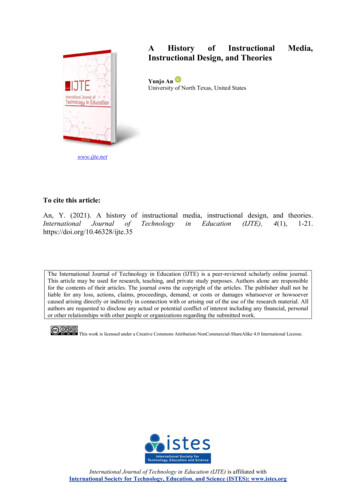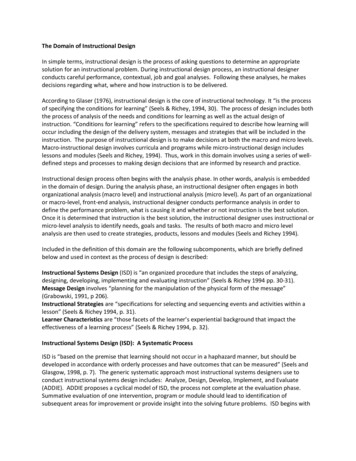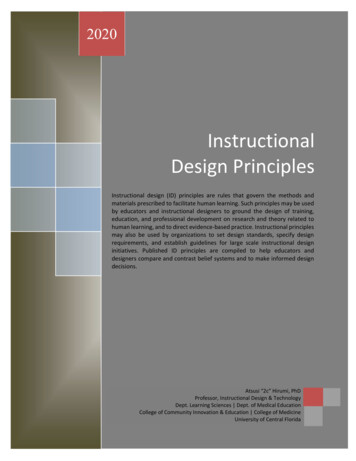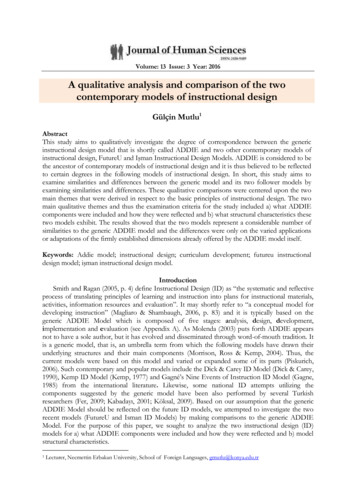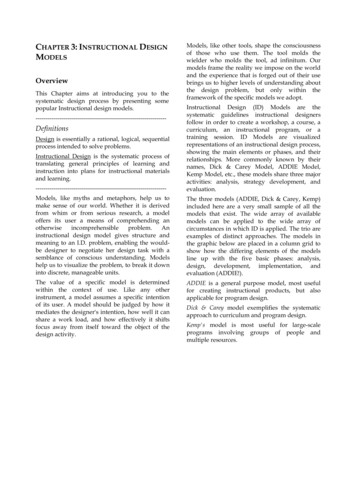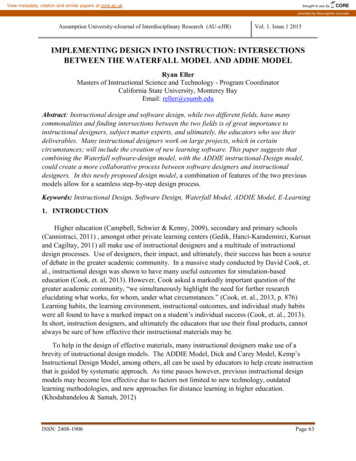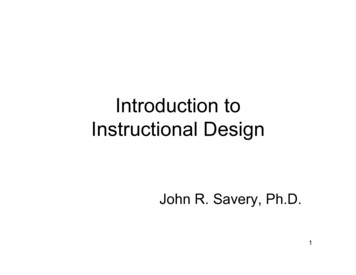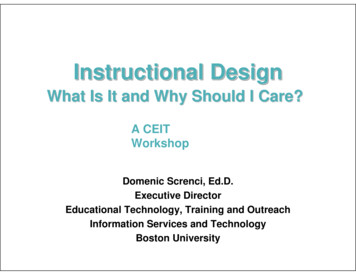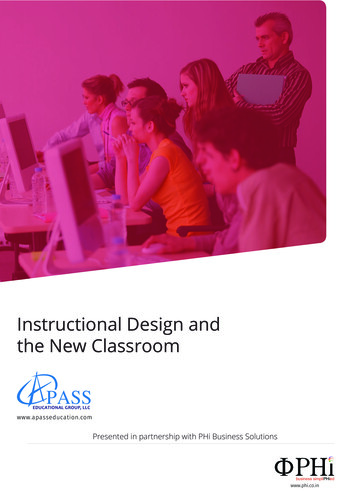
Transcription
Instructional Design andthe New ClassroomPASSEDUCATIONAL GROUP, LLCwww.apasseducation.comPresented in partnership with PHi Business Solutionsbusiness simpliPHiedwww.phi.co.in
2Instructional Design and the New ClassroomThe concept of “classroom” is going througha revolution in front of our eyes. Because ofthe digital revolution and the proliferation ofvaried and easily accessible online content, theclassroom is moving from its bricks-and-mortarorigins toward a more flexible and creative future.Instructional design is at the center of therevolution in education. As technology makesit possible to deliver expanded varieties ofcontent and new methods of instruction, it fallson the instructional designer to make gooddecisions as to what works, and what does not.In this and the next five A Pass Angles, we willlook at instructional design in the technologicalage, and offer some opinions as to best practices.We will be discussing methods for encouragingPASSEDUCATIONAL GROUP, LLCwww.apasseducation.comstudent engagement, for achieving excellenteducational results, and for meeting programgoals across the board.The addition of technology to a learningprogram must be matched with fundamentalrestructuring of how students are taught. Thiscan include changes to the classroom layout,reorganization of the curriculum, and new waysof (and uses for!) assessment.But before we get too deep into specifics, weshould take a more general look at the role ofthe instructional designer.Additional reading: The Classroom Has Come aLong Way.business simpliPHiedwww.phi.co.in
3Instructional Design and the New ClassroomWhat Is Instructional Design?The simplest way to understand instructionaldesign is to differentiate it from instruction.Instruction is the teaching of subject mattercontent; instructional design addresses how thatmaterial is taught. Anyone who is helping studentslearn uses ID, whether they employ a blackboardand a piece of chalk or a digital device. Thus,educators who create lesson plans—whetherfor a single class or for many—are designinginstruction. New technology and learning systemsmay make it easier to create and activate theplans, but they still include familiar features: Becoming familiar with learners tounderstand how they approach instruction Aligning learning to educationalstandards and objectives Facilitating learners’ knowledgeacquisition Assessing (at various points) learners’understanding and retention Providing opportunities for projectbased and cooperative learning Linking classroom study to real-worldapplicationsID provides teachers with multiple advantages: It gives them the ability tounderstand learners—where andhow they are approaching theinstruction—and to tailor instructionto best effect.PASSEDUCATIONAL GROUP, LLCwww.apasseducation.com It aligns instruction to standards andobjectives, ensuring that learners areexposed to and assimilate requiredknowledge and skills. It promotes more effective planning andco-teaching, allowing teachers to usetime and resources more efficiently. It ensures that all students meettheir targets, via either a linear paththrough the curriculum or a loopingpath that includes remediation.Because of the close teacher-learner relationship,these advantages are translated to learners: Learners can access resourcesneeded to reach their goals in atimely manner. Increased engagement meansthat learners are more likely tobusiness simpliPHiedwww.phi.co.in
4Instructional Design and the New Classroomtake ownership of their education,resulting in better outcomes. Assessment is consistently alignedto objectives and the knowledge andskills learners have acquired.What Is the Instructional Design Process?Expert instructional designers follow a wellrecognized process in order to plan instruction.Patricia Smith and Tillman Ragan of OklahomaUniversity explain that instructional designerscomplete three major and interconnectedactivities during the design and developmentprocess:1. Perform an instructional analysis todetermine the goals of instruction.2. Design an instructional strategy in orderto use the instructional medium toaccomplish the goals.3. Develop and conduct an evaluation todetermine how well students learnedand what revisions to instructionalmaterials are needed.Each of these activities is carried out withpainstaking attention to detail so that, whenthe plan is put into action, it operates with aminimum of difficulty.1. Perform an Instructional Analysis. Duringthis analysis, the designer delves notonly into the learning environment andthe learning tasks, but also the learnersthemselves. A lot of questions need to beasked:PASSEDUCATIONAL GROUP, LLCwww.apasseducation.comAbout the learners: Who they are, whatinterests and prior knowledge they have,and how they feel about the learning.About the environment: Where learners willbe located (remotely or centrally), how muchtime is available for learning, and whattechnology learners will be using.About the tasks: What goals learners haveto reach, what skills and knowledge theyneed to acquire, and how their achievementshould be assessed.2. Design an Instructional Strategy. Duringthis stage, the instructional designer asksquestions about how content should bepresented, which learning activities (andtheir sequence) will work best for thelearners, and what media to use to supportthe instruction.About the content: What kinds of contentmust students learn, what size chunksshould be presented, and whether thecontent should be presented or embeddedin activities.About the activities: What activities shouldbe used and what role learners will have,whether activities are primary or supportivemodes of learning, how activities should besequenced, and whether students will belearning by discovery or by explanation.About the media: Will learners benefitmost from digital sources or textbooks, andshould learners participate in groups or ontheir own.business simpliPHiedwww.phi.co.in
5Instructional Design and the New Classroom3. Conduct an Evaluation. In order to beable to make necessary improvements,the designer asks questions about theinstructional materials, the processesthrough which students learn, and howrevisions can be made.About the instructional materials: Is thecontent still accurate and up-to-date, andis it accessible and understandable by thestudents.About the learning processes: Howcan different processes be bestevaluated, whether they should beevaluated in a group or individual setting,and how frequently evaluations shouldbe made.Why Should We Use Instructional Design?Instructional design seems like a complexand never-ending way of doing somethingthat might be seen as a natural skill of anytalented teacher. So why involve professionalinstructional designers at all?Smith and Ragan1 point out a number ofcompelling reasons to use designers: In their constant querying aboutlearners and content, designers becomestand-ins for the ultimate learners. Thisis more likely to place the learners asthe focus of instruction. The process of design focuses oneffective, efficient, appealing instruction.This discards inappropriate content,increases learner engagement, andprovides opportunities to evaluate andrevise the plan. The systematic process anddocumentation promote coordinationbetween the people involved indesigning, producing, and deliveringinstruction. This makes implementationof the plan easier and more uniform,and lays the foundation for any revisionsthat must be made. The process supports developmentof alternate means of deliveringinstruction. Since the ID product isindependent of the specific media usedfor instruction, the strategies are validacross multiple platforms.About the revisions: What revisions shouldbe made, and how frequently they shouldbe made.As you might suspect, this process is not linear,but has multiple feedback loops that looksomething like this:PASSEDUCATIONAL GROUP, LLCwww.apasseducation.combusiness simpliPHiedwww.phi.co.in
6Instructional Design and the New Classroom The process helps ensure that what istaught is what is needed for learnersto achieve required goals and thatevaluation will be accurate andappropriate.Finally, watch this TED talk: “ReimaginingLearning.” Richard Culatta is one of the foundersPASSEDUCATIONAL GROUP, LLCwww.apasseducation.comof InstructionalDesign.org, which provideseducation about ID and acts as a clearinghousefor sources about instructional design.Notes Patricia L. Smith, Tillman J. Ragan, InstructionalDesign, 3rd Edition, November 2004, 2005.1business simpliPHiedwww.phi.co.in
Beyond 1 2 3.Instructional Design and the New Classroom117PASSEDUCATIONAL GROUP, LLCA Pass Educational Group, LLC is veryproud of its reputation for deliveringhigh-quality work on time.We are also proud of ourreputation as being responsive,friendly, and easy to work with.Finally, we cherish the loyalty of our staff and contract associates. We offer the following services: Instructional Design. A Pass recognizesthat high-quality learning requiresexemplary instructional design. Studentsand teachers must fully understandexpectations and easily engage in contentfor optimum learning. Read MoreCourse Development. The A Pass teamcan develop courses and /or lesson plansin any subject area. If we do not have theappropriate resources in house, we have theability to find them. Read MorePASSEDUCATIONAL GROUP, LLCwww.apasseducation.comwww.apasseducation.com Editing. A Pass has deep experience editingclient content and resources—this includesdevelopmental editing, copy editing,fact checking, and more. Read More Assessment Design. A Pass developsmany types of assessment questions,including multiple choice, true/false,constructed response, short essay,technology-enhanced items (TEIs) andmore. We design assessments to accompanytextbooks and study aids as well ashigh-stakes assessments for state andnational standardized exams. Read Morebusiness simpliPHiedwww.phi.co.inwww.learnosity.com
8Instructional Design and the New Classroombusiness simpliPHiedPHi Business SolutionsPHi is a leading content solutions providerto educational publishers, institutions andcorporates globally. The company is focusedon delivering solutions and value for dataintensive business processes that helporganizations across the world overcome theirdata management challenges. These solutionsleverage innovations in technology, businessprocesses, domain knowledge and provide ourclients with a competitive edge.As a strategic partner, PHi empowers its clientsto take advantage of the revolution in contentcreation and management and be innovativeand different. Leveraging cutting-edgetechnology, PHi’s solutions enhance customerperformance and optimize productivity andefficiency in business processes at a lower cost.We are a trusted life cycle partner to our clientsglobally!PHi is part of the 300 million Modern Group,which has interests as diverse as “special& alloy steel” manufacturing, automotiveengineering, Industrial dairy products, high-endnutraceuticals, and IT enabled services.We offer the following services:PASSEDUCATIONAL GROUP, LLCwww.apasseducation.combusiness simpliPHiedwww.phi.co.in
Patricia Smith and Tillman Ragan of Oklahoma University explain that instructional designers complete three major and interconnected activities during the design and development process: 1. Perform an instructional analysis to determine the goals of instruction. 2.


